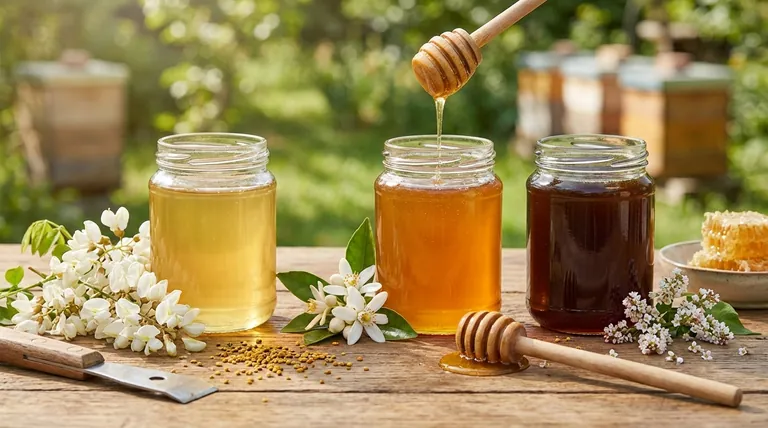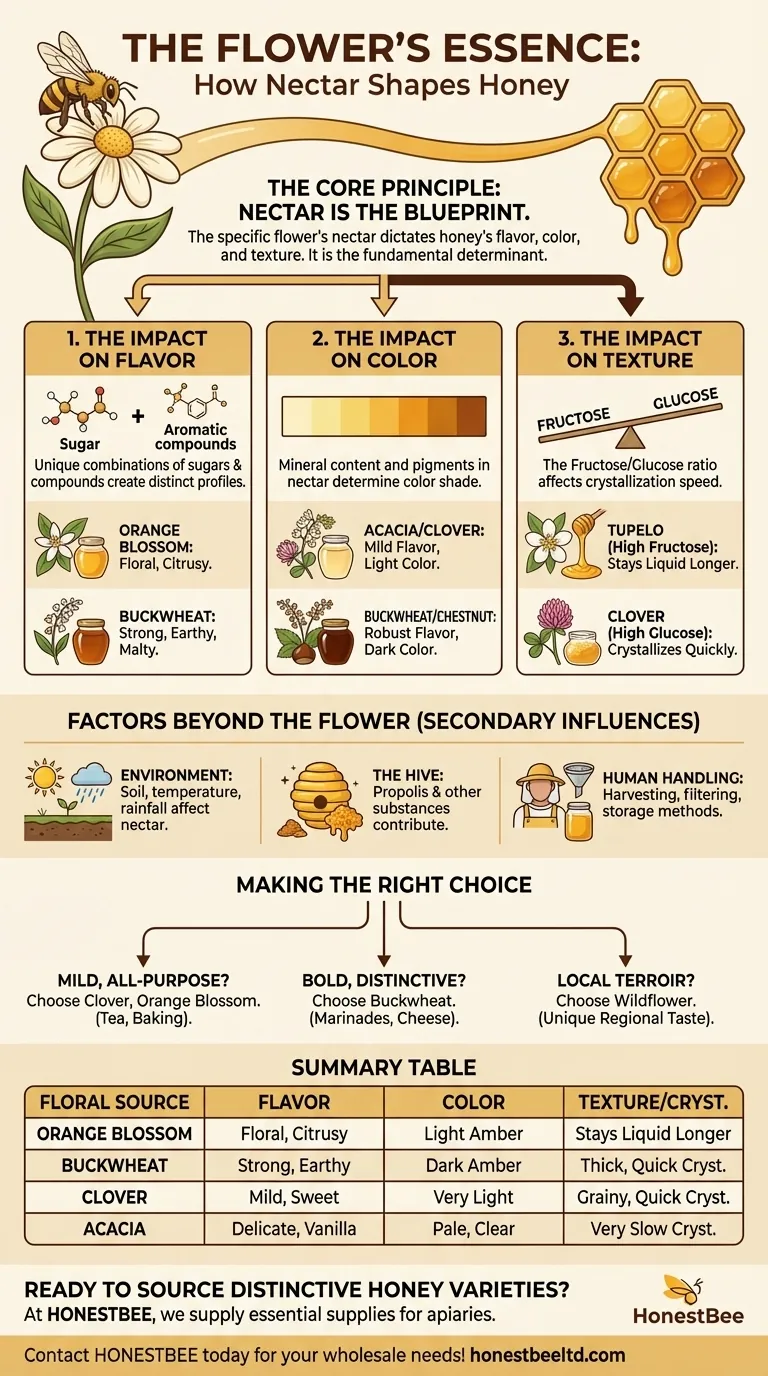At its core, the type of flower is the single most important factor determining a honey's character. The specific nectar source dictates the final honey's flavor profile, its color from light to dark, and even its texture and tendency to crystallize. For example, nectar from citrus blossoms creates a light-colored honey with a distinctly subtle citrus taste.
While environmental conditions and handling methods play a role, the floral nectar source is the fundamental blueprint for every distinct variety of honey. Understanding this relationship is key to appreciating the vast world of honey.

How Floral Nectar Defines Honey
The journey from nectar to honey is a transformative process, but the starting material provided by the flower sets the stage for everything that follows. The unique chemical composition of each flower's nectar is directly responsible for the final product's sensory characteristics.
The Impact on Flavor
Different nectars possess unique combinations of sugars (fructose, glucose, sucrose) and hundreds of other volatile organic compounds. These compounds create the distinct aromatic and flavor profiles we associate with different honeys.
This is why orange blossom honey has a floral, citrusy note, while buckwheat honey is known for its strong, earthy, and malty flavor. The bees are simply concentrating the essence of the flower.
The Impact on Color
The color of honey can range from nearly clear to a deep, dark brown. This variation is almost entirely due to the mineral content and other pigments present in the original plant nectar.
Typically, lighter-colored honeys like acacia or clover are milder in flavor. Darker honeys, such as those from buckwheat or chestnut flowers, tend to be much more robust and full-flavored.
The Impact on Texture
The ratio of fructose to glucose in the nectar determines the honey's texture and how quickly it will crystallize.
Honey with a higher fructose content, like tupelo honey, will remain liquid for a very long time. In contrast, honey with a higher glucose content, like clover honey, tends to crystallize more quickly into a thicker, grainier texture.
Factors Beyond the Flower
While the nectar source is primary, other variables can introduce subtle or significant changes to the final honey in the jar.
Environment and Location
The specific environment—including soil composition, temperature, and rainfall—can influence a plant's nectar production. Two fields of the same flower in different regions might produce nectars with slightly different chemical makeups, leading to subtle variations in the honey.
The Influence of the Hive
Other substances within the hive can be mixed into the honey in trace amounts. The presence of propolis, a resinous compound bees produce, can add to the honey's unique properties and taste.
Human Handling
Once the honey is removed from the hive, human intervention matters. The methods used for harvesting, filtering, and storing the honey can all affect its final characteristics. Over-filtering, for example, can remove pollen and other compounds that contribute to flavor.
Making the Right Choice for Your Goal
Understanding how flowers shape honey allows you to select the perfect type for any application.
- If your primary focus is a mild, all-purpose sweetener: Choose a light-colored honey like clover or orange blossom for tea, baking, or general use where you don't want to overpower other flavors.
- If your primary focus is a bold, distinctive flavor: Opt for a dark, robust honey like buckwheat for use in marinades, barbecue sauces, or as a finishing drizzle on strong cheeses.
- If your primary focus is exploring local terroir: Seek out "wildflower" honey from a local beekeeper, which offers a unique and complex taste of the specific region's blended flora.
By recognizing the floral origin of honey, you can better appreciate its incredible diversity and make more informed choices.
Summary Table:
| Floral Source | Typical Flavor Profile | Color | Texture / Crystallization |
|---|---|---|---|
| Orange Blossom | Floral, Citrusy | Light Amber | Stays Liquid Longer |
| Buckwheat | Strong, Earthy, Malty | Dark Amber | Thick, Crystallizes Quickly |
| Clover | Mild, Sweet | Very Light | Grainy, Crystallizes Quickly |
| Acacia | Delicate, Vanilla-like | Pale, Clear | Very Slow to Crystallize |
Ready to Source or Produce Distinctive Honey Varieties?
Understanding floral sources is key to producing and selling high-quality honey. At HONESTBEE, we supply the essential beekeeping supplies and equipment that commercial apiaries and distributors need to manage hives for specific honey crops—from hive components to harvesting tools.
Let us help you optimize your operations for the honey varieties your market demands.
Contact HONESTBEE today to discuss your wholesale supply needs!
Visual Guide

Related Products
- Stainless Steel Honey Press Wax Press with Tank
- Honey Wax Separating Wax Press with Metal Screw Wax Separator Machine
- Stainless Steel Manual Honey Press with Guard for Pressing Honey and Wax
- Inverted Squeezable Honey Jar with No Drip Flip Top Cap for Easy Pouring
- Double Wall Honey Heating Stirring Homogenizer Mixing Machine with Various Capacity
People Also Ask
- What happens to the wax after pressing in a honey press? A Guide to Maximizing Your Hive's Yield
- What are the key features of a honey press? Maximize Yield with Durable, Efficient Extraction
- How does the press method for extracting honey work? A Simple, Low-Cost Guide for Beekeepers
- How does pressed honey compare to extracted or crush-and-strain? Unlock the Full Flavor of the Hive
- What are the multipurpose functionalities of a honey press? Versatile Harvesting for Beekeepers & Homesteaders



















